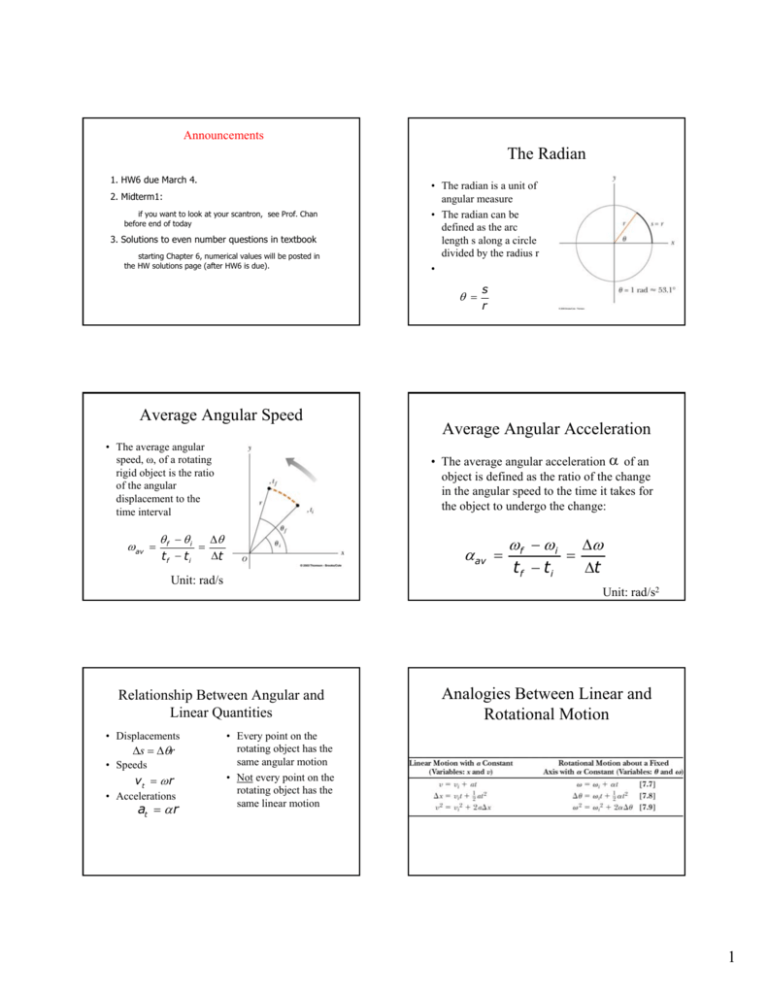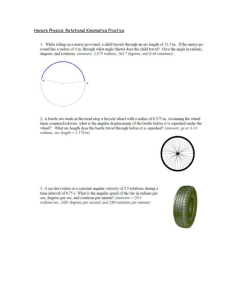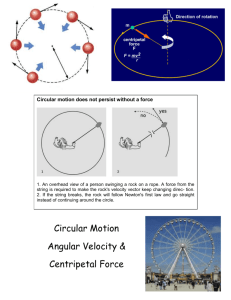The Radian Average Angular Speed Average Angular Acceleration
advertisement

Announcements The Radian 1. HW6 due March 4. 2. Midterm1: if you want to look at your scantron, see Prof. Chan before end of today 3. Solutions to even number questions in textbook starting Chapter 6, numerical values will be posted in the HW solutions page (after HW6 is due). • The radian is a unit of angular measure • The radian can be defined as the arc length s along a circle divided by the radius r • θ = Average Angular Speed • The average angular speed, ω, of a rotating rigid object is the ratio of the angular displacement to the time interval ω av = θf − θi tf − ti = ∆θ ∆t α av = • Speeds vt = ω r • Accelerations at = α r ωf − ωi tf − ti = ∆ω ∆t Unit: rad/s2 Relationship Between Angular and Linear Quantities ∆s = ∆θr Average Angular Acceleration • The average angular acceleration α of an object is defined as the ratio of the change in the angular speed to the time it takes for the object to undergo the change: Unit: rad/s • Displacements s r Analogies Between Linear and Rotational Motion • Every point on the rotating object has the same angular motion • Not every point on the rotating object has the same linear motion 1 A coin with a diameter of 2.40 cm is dropped on edge onto a horizontal surface. The coin starts out with an initial angular speed of 18.0 rad/s and rolls in a straight line without slipping. If the rotation slows with an angular acceleration of magnitude 1.90 rad/s2, how far does the coin roll before coming to rest? Centripetal Acceleration • Centripetal refers to “center-seeking” • The direction of the velocity changes, the speed remains constant • The acceleration is directed toward the center of the circle of motion Centripetal Acceleration – The magnitude of the centripetal acceleration is given by v2 ac = ∆θ – This direction is toward the center of the circle ∆θ t r The angular velocity and the linear velocity are related (vt = ωr) The centripetal acceleration can also be related to the angular velocity a C = ω 2r ∆θ Newton’s Second Law says that the centripetal acceleration is accompanied by a force FC = maC FC stands for any force that keeps an object following a circular path • Tension in a string • Gravity • Force of friction • General equation FC = m aC = m v2 r • If the force vanishes, the object will move in a straight line tangent to the circle of motion 2 Level Curves • Friction is the force that produces the centripetal acceleration • Can find the frictional force, µ, or v Banked Curves • A component of the normal force adds to the frictional force to allow higher speeds v2 rg or ac = g tan θ tan θ = Homework problem in webassign Vertical Circle • Look at the forces at the top of the circle • The minimum speed at the top of the circle can be found v top = gR Total Acceleration • The tangential component of the acceleration is due to changing speed • The centripetal component of the acceleration is due to changing direction • Total acceleration can be found from these components a = a 2t + aC2 3










